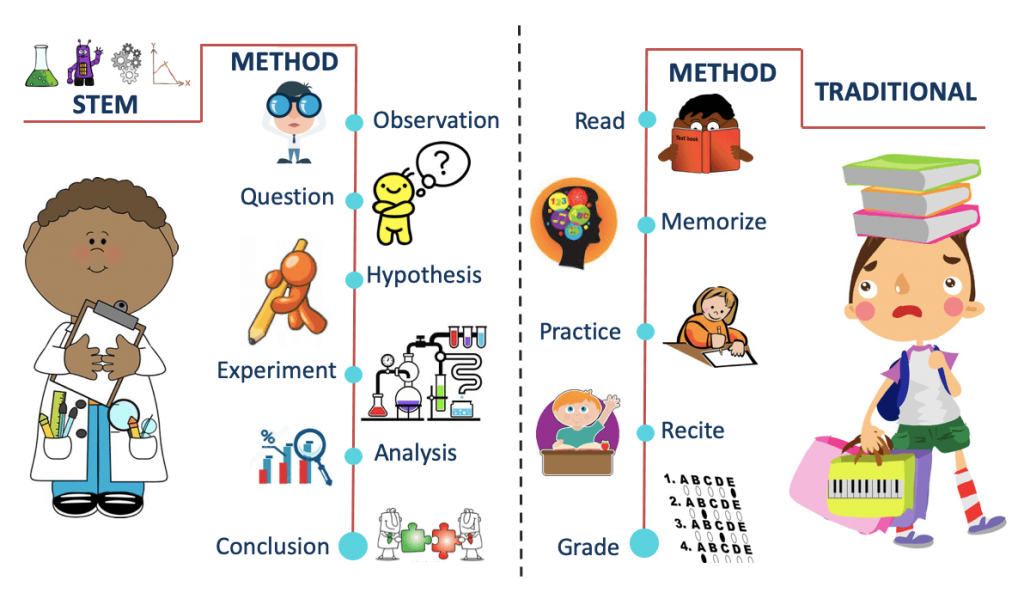Introduction
Recently, an increase in non-formal educational activities has been noticed worldwide, aiming to introduce innovative ways of teaching for many subjects including those related to STEM (Science, Technology, Engineering, Mathematics) as well as integrating creativity, fun, and playfulness into the teaching process. A disconnection between school and the real world makes it crucial for students to be properly trained and be able to solve real-life problems.[4] STEM education is considered to be a relatively new form of education that originated from the US aiming to fill the gap in regards to those fields by properly educating and training new generations with practical skills and knowledge associated with labor demands. [2]
Potentials
STEM education aims in eliminating the gap between the skills learned at schools and the skills which are actually needed in the current industry. Many graduates are unable to find work, however by teaching STEM-oriented subjects from a young age (e.g., to kindergarten students) can help them develop and improve skills, such as creativity, teamwork, critical thinking, and problem-solving, all necessary for the skill required in a 21st-century learning and teaching environment. [5]
According to Petnuchova (2012), non-formal education is a learning process resulting from individual initiative and could further outgrow more organized activities, that either includes distinct learning objectives or do not. [3] Thus, students can learn in a more relaxed, playful, and less structured environment by using something intriguing to them (like 3D print exhibits or E-books) or by using materials, approaches and games that they are already familiar with and enjoy (like cards games) [1].

source: https://yetiacademy.com/reasons-why-stem-education-is-important-in-2021/
Non-formal educational activities are designed for students from distinct socio-cultural backgrounds and can participate in these out-of-school activities and to therefore learn to promote equity in education. [6] Ha Giang city’s community learning centre provides many free-of-charge programs such as the Stem Fair and STEM on the Move program by inviting the community to participate, learn and have fun free of charge. [2]
Through the non-formal approach, more girls could develop an interest in such sciences as the teaching process of these subjects will be appealing to them, including games and approaches that they will enjoy learning. As a result, they will create a more positive attitude toward STEM subjects, making them more popular with the female population and reduce gender inequality. This could include specific hobbies, community events, visits to museums, zoos and aquariums, summer science camps, and programmes.[6]
The non-formal approach could be applied in combination with the formal. Schools and community organizations can share their goals, visions, and tools to further combine and support a connected and well-rounded knowledge for students. [6] Furthermore, teachers can also benefit from the non-formal approach as they may find it very interesting and helpful, allowing them further to use innovative ways when delivering formal content as well as when trying activities that can help their students to better understand STEM concepts and improve their performance. They also improve skills such as leadership, creativity, and social skills. [4]

source: https://kidpillar.com/what-is-stem-education-and-why-is-it-important-for-kids/
Limitations
A study by Microsoft, suggests that girls’ interest in STEM starts to decline at around 12 years old, and it starts to increase at around 20 years old. [1] However at this stage usually they have already determined their career direction and this could limit the possibility for female inclusion and interest in participating in such activities. Other studies have shown that the decreasing level of female interest in STEM-oriented fields is due to a lack of self-confidence developed during early-age stages. [1]
Many teachers could be discouraged in applying non-formal education because learning materials and teaching approaches for non-formal education are hard to find.
Furthermore, many people are suspicious of the non-formal approach and doubt its results. This could lead to a not very good collaboration with parents or other teachers [1]
Lastly, the results of non-formal education regarding the limited financial support are vaguer, more unclear, therefore more difficult to measure as well as justify the amount of money needed. [3].
References
[1] https://www.sciencedirect.com/science/article/pii/S2212868920300167
[2] https://iopscience.iop.org/article/10.1088/1742-6596/1340/1/012033/pdf
[3] https://www.ijrte.org/wp-content/uploads/papers/v7i6s5/F11320476S519.pdf
[4]https://www.tandfonline.com/doi/full/10.1080/02607476.2018.1422613?scroll=top&needAccess=true
[5] STEAM_learning_in_formal_and_informal_settings_via%20(1).pdf